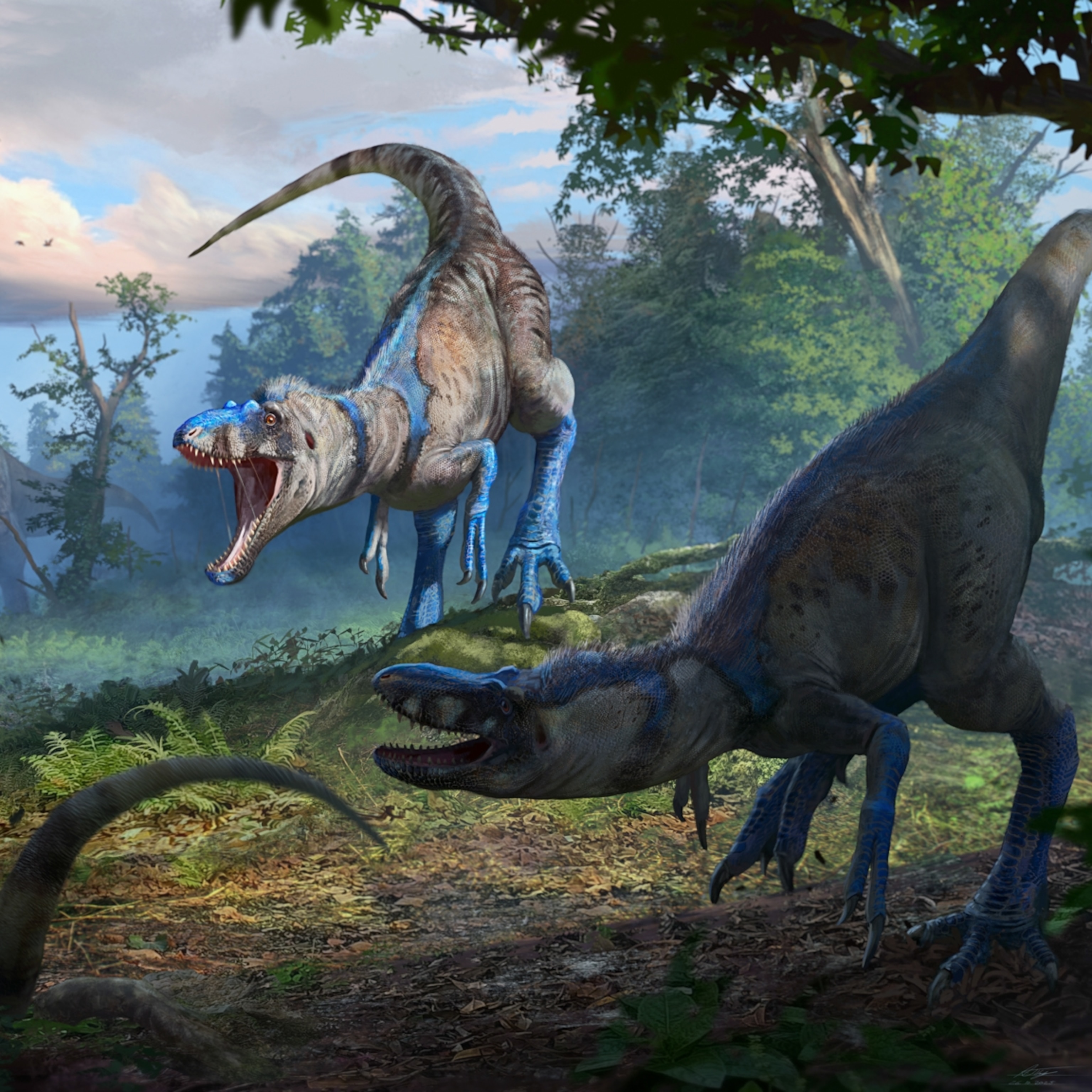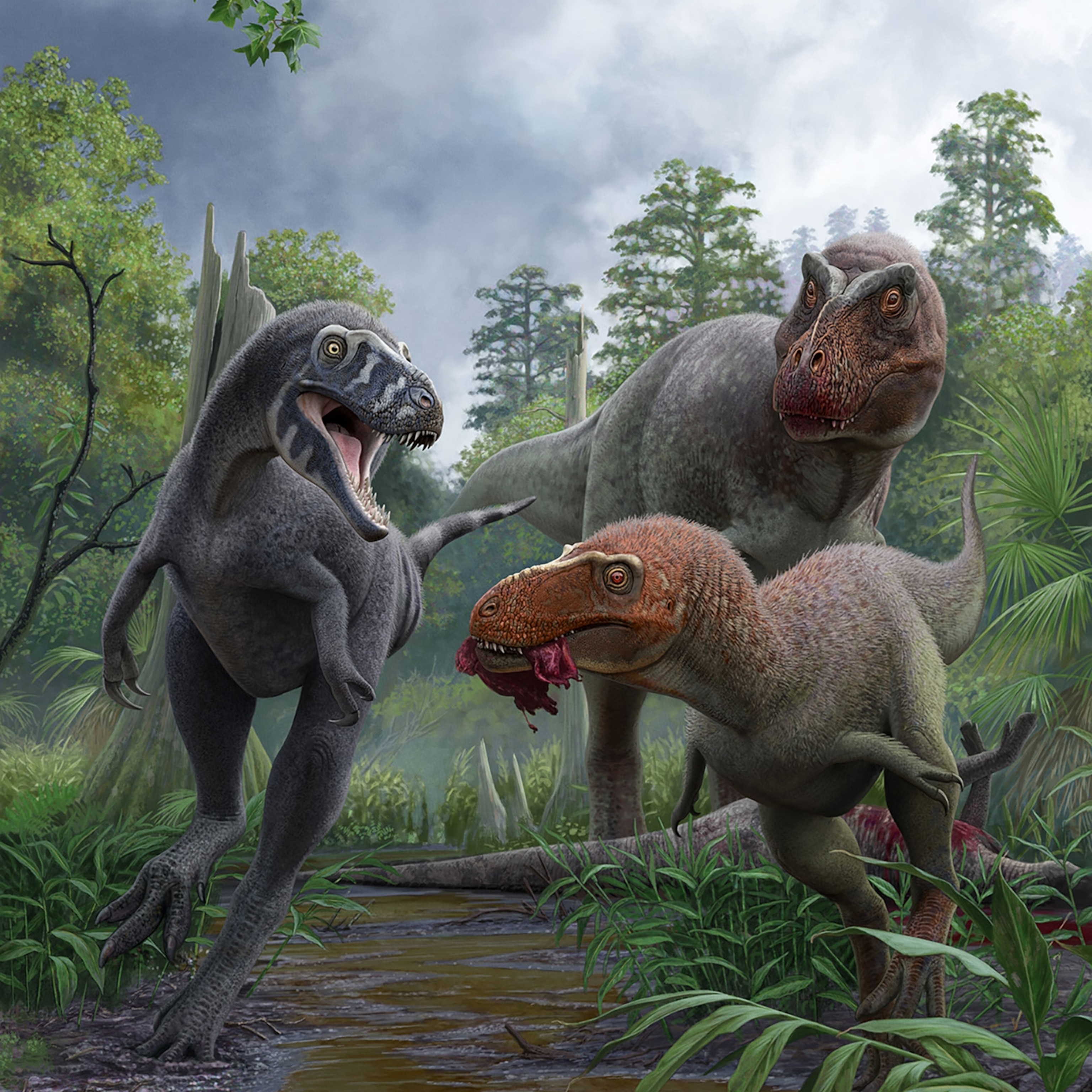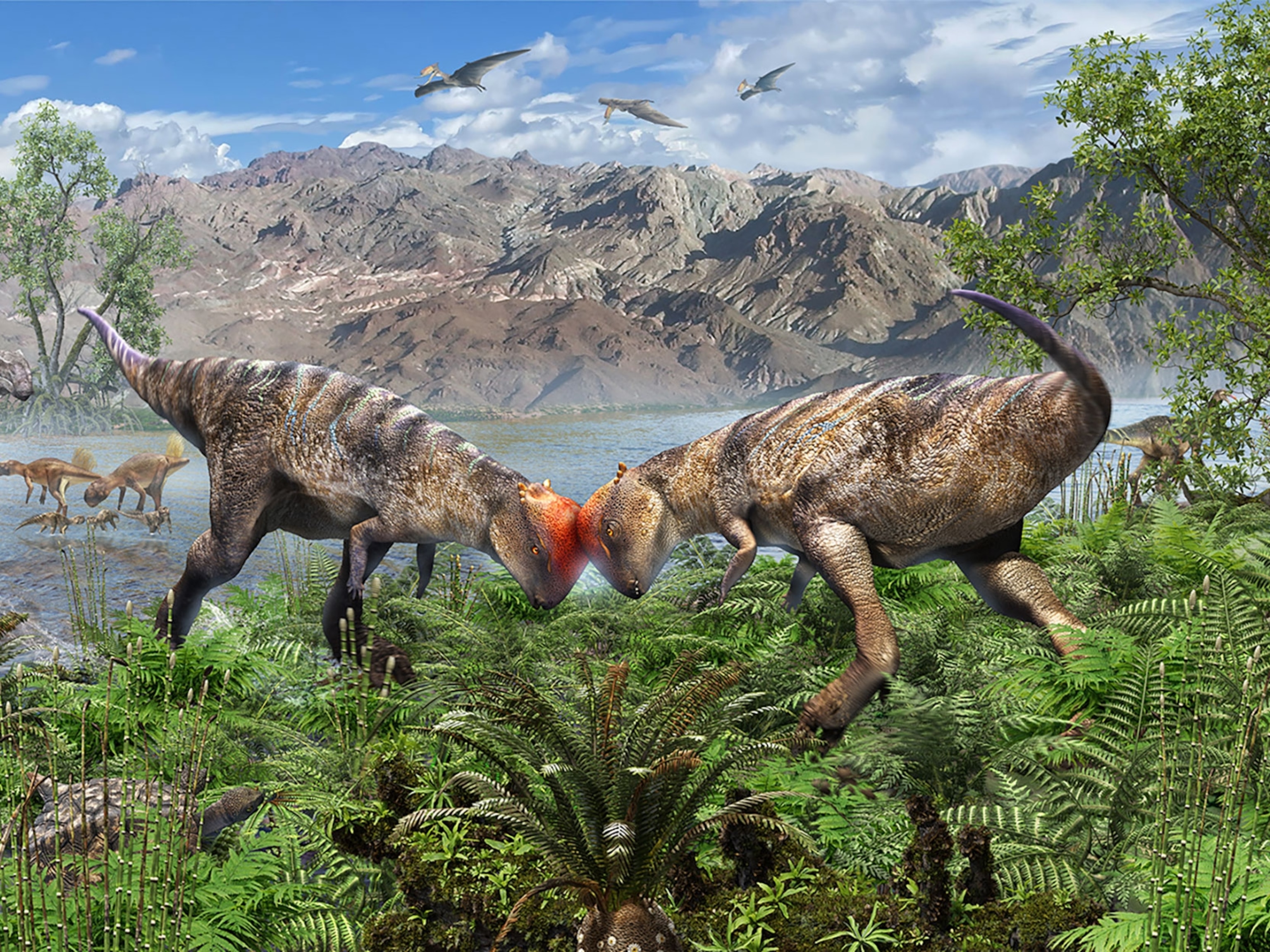More than three decades ago in South Dakota, an amateur paleontologist named Stan Sacrison discovered a titan of the ancient Earth: the fossil of a mostly complete, 39-foot-long Tyrannosaurus rex. Nicknamed “Stan” after its discoverer, the beast was excavated in 1992 and has long been housed at the private Black Hills Institute of Geological Research in Hill City, South Dakota. But even if you’ve never been there, chances are good that you’ve seen this particular T. rex. Dozens of high-quality casts of its bones are on display in museums around the world, from Tokyo to Albuquerque, New Mexico.
Now, an auctioneer’s hammer has thrown Stan’s future into question, with the dinosaur bones sold off to the highest—and, so far, anonymous—bidder, stoking fear among experts that this beloved T. rex may be lost to science.
On October 6, the London-based auction house Christie’s sold the T. rex for a record $31.8 million, the highest price ever paid at auction for a fossil. The previous record was set in 1997 with the sale of “Sue,” a largely complete T. rex dug up by the same South Dakota institute and eventually purchased by the Field Museum of Natural History in Chicago for $8.36 million (equivalent to nearly $13.5 million today).
The day after Stan was sold, paleontologist Lindsay Zanno of the North Carolina Museum of Natural Sciences described the sale price as “simply staggering.”
“That’s an astronomical price that borders on absurdity, based on my knowledge of the market,” added paleontologist David Evans, the vertebrate paleontology chair at the Royal Ontario Museum in Toronto, who suggested the anonymous buyer could have spent the same funds in a far more effective way to deepen humanity’s understanding of the prehistoric beasts. “If this kind of money [were] invested properly, it could easily fund 15 permanent dinosaur research positions, or about 80 full field expeditions per year, in perpetuity,” he wrote in an email interview.
Scientists also have raised concerns about the negative ripple effects the sale could have on the study of dinosaurs by incentivizing people to seek out and sell well-preserved fossils rather than leaving them for paleontologists to study. (Find out more about the U.S. fossil trade in National Geographic magazine.)
“This is terrible for science and is a great boost and incentive for commercial outfits to exploit the dinosaur fossils of the American West,” says tyrannosaur expert Thomas Carr, a paleontologist at Carthage College in Kenosha, Wisconsin.
Paleontologists fear that if the buyer turns out to be a private collector, researchers and the public could lose access to the fossil, limiting their ability to repeat results such as measurements of its bones or conduct new analyses with more advanced tools and techniques. (Find out how scientists are reimaging dinosaurs in today’s “golden age” of paleontology.)
The ability to repeat experiments is “a tenet of science; it's part of our ethical foundation,” Zanno says. “The paleontological world is holding its breath” to find out Stan’s future.
Why sell Stan?
The Black Hills Institute is perhaps best known for its involvement in the collection of—and years-long custody battle over—the T. rex named Sue, which involved an FBI raid and a legal dispute with the Cheyenne River Sioux. While not quite as dramatic, Stan’s sale also stems from a court ruling. (Find out more about Sue, the world’s most famous T. rex, in National Geographic magazine.)
For years, the Black Hills Institute had Stan on display in its Hill City museum. In addition to selling resin casts to other museums, the institute gave researchers access to the fossil, resulting in a flurry of scientific papers about everything from T. rex’s immense bite force to how the skull of T. rex could flex and move.
“The skeleton of Stan is without doubt one of the very best Tyrannosaurus rex specimens ever found, and it’s been published in the scientific literature many times,” Evans says. “Stan is one of the keystone specimens for understanding T. rex.”
Carr, for one, included Stan in three studies of tyrannosaur diversity and skull shape earlier in his career. He now regrets that decision because the fossil was always in private hands and therefore at risk of being sold. “In the end, I wound up contributing to the successful sales pitch of the fossil … along with the other 45 scientific publications on Stan,” he says. “We shouldn't have touched it with a 10-foot pole.”
Stan’s path to the auction block began in 2015, when Neal Larson, a 35-percent shareholder in the Black Hills Institute (and brother of the institute’s president, paleontologist Pete Larson), sued the company to liquidate its assets. According to South Dakota’s Rapid City Journal, the company had removed Neal Larson from its board of directors three years earlier, after a bitter dispute over business dealings and his defense of a former employee accused of sexual misconduct.
A judge ruled in 2018 that Stan had to be auctioned off to pay Neal Larson for his stake in the institute, according to a company press release. Despite Stan’s sale, the Black Hills Institute retains the rights to make and sell future casts of the T. rex’s bones, including full-size replica skeletons.
“We were saddened to learn that the winner of the auction was probably not a museum, but we are hopeful that the new owner will eventually put Stan on display so the public will be able to continue to see and study this awesome original skeleton,” Pete Larson said in an October 7 press release.
In 2018, James Hyslop, the head of the science and natural history department at Christie’s, began to shepherd Stan through the auction process. On October 6, Hyslop was on the phone with the anonymous bidder, calling out their winning purchase price from Christie’s London office.
In an email to National Geographic, Hyslop declined to comment on the winning bidder’s identity, or even whether the buyer was a private collector or a public research institution. “As is the case with all successful sales, we are pleased to have achieved a strong result,” he wrote. “It has been an honor to have had the opportunity to work with such an extraordinary specimen.”
Luxury and loss
In the U.S., fossil bones found on federal land are public property and can be collected only by researchers with permits. These remains also must stay in the public trust, in approved repositories such as accredited museums.
However, fossils discovered on U.S. private land can be bought and sold, and Stan isn’t the only U.S. dinosaur fossil recently on the auction block. In 2018, the French auctioneer Arguttes sold off a skeleton of the predatory dinosaur Allosaurus, drawing criticism from scientists because its sale, like Stan’s, risked creating the perception that dinosaurs were worth more in dollars than they were in discoveries.
The 2,000-member Society of Vertebrate Paleontology (SVP), which represents paleontologists around the world, opposes fossil auctions and has long discouraged the study of privately held fossils, out of concern that researchers and the public wouldn’t always be guaranteed access to them. In September, the organization sent a letter to Christie’s asking them to restrict bidders for Stan to public research institutions. In its reply, Christie’s acknowledged the society’s stance but said that the sale couldn’t be restricted, according to University of Bristol paleontologist and outgoing SVP president Emily Rayfield, who co-signed the society’s letter.
“The high-profile nature of the auction and the publicity surrounding the auction event were designed to appeal to high-end bidders, thereby elevating the price of fossil material and promoting fossils as luxury items,” Rayfield wrote in an email interview. “How can public trust institutions spend this kind of money on single fossil specimens—money that could fund jobs, field programs, training, exhibits, and much more?”
Other countries take stricter stances on the fossil trade. In Alberta, Canada, for instance, fossils found in the province can’t be exported, thanks to a 1970s law that designated fossils part of Alberta’s natural heritage. Similar laws are also on the books in paleo-hotspots such as Brazil, China, and Mongolia. However, Evans says that black markets persist in fossils from these countries, in part because of the allure of huge paydays. (Find out more about the Mongolian fossil black market—and one scientist’s fight against it.)
“The sale of Stan will perpetuate more pillaging of protected fossils in a big way,” Evans says. “It’s heartbreaking.”
University of Calgary paleontologist Jessica Theodor, SVP’s incoming president, adds that auctions don’t just price out researchers—they can shape the hunt for fossils for years to come. After Sue’s multimillion-dollar sale in 1997, some U.S. researchers were shut out of private land sites they had worked on for decades, Theodor says, in part because landowners wanted to sell their fossils or lease their land’s fossil-digging rights to private companies. Paleontologists also saw a rise in vandalism at fossil sites as robbers tried to steal what they thought were valuable remains.
“A big sale like this stands to do much more damage than [the sale of] Sue did,” Theodor said.
A paleontological plea
Commercial fossil diggers in the U.S. have long argued that their business model brings important fossils to light, because the profit motive encourages more people to dig. The most reputable of these firms excavate and prepare fossils to high standards, and they contact researchers when they’ve found fossils of clear scientific significance.
At its best, this system can find and protect invaluable fossils, such as the armored dinosaur Zuul crurivastator, which U.S. fossil firm Theropoda found on private Montana ranchland in 2014. Once Theropoda realized what it had, it contacted Canada’s Royal Ontario Museum, which sent researchers to the site and bought the fossil for an undisclosed sum in 2016. (Learn more about Zuul and its remarkable armor in National Geographic magazine.)
For all the debate around commercial sales, public auctions are beasts unto themselves. Bidding wars can drive up a fossil’s price to far beyond what any university or museum could afford. As a result, fossils that would otherwise enter the public trust go into private collections instead.
Stan appears to be the spoils of such a war. During Tuesday’s auction, two bidders drove Stan’s price up by millions of dollars in a matter of minutes. The meteoric rise almost certainly priced out most public institutions—especially this year, as COVID-19 has financially devastated museums the world over.
The paleontologists contacted by National Geographic urged Stan’s new, anonymous owner to donate the T. rex specimen to a museum or research institution.
“Do the right thing: totally relinquish your ownership of the fossil and donate it to an accredited natural history museum so that science can ethically be done on Stan for the benefit of everyone on the planet who has an interest in dinosaurs,” Carr urged.
“You have the opportunity to share a treasure with the world,” Zanno added. “It's a rare gift—take it.”









